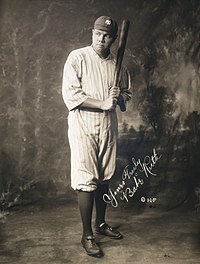 |
In baseball statistics, slugging percentage (abbreviated SLG) is a popular measure of the power of a hitter. It is calculated as total bases divided by at bats:

where AB is the number of at-bats for a given player, and 1B, 2B, 3B, and HR are the number of singles, doubles, triples, and home runs, respectively. Walks are specifically excluded from this calculation. The name is a misnomer, as the statistic is not a percentage but a scale of measure whose computed value is a real number in the interval ![left[0, 4right]](http://upload.wikimedia.org/math/1/c/3/1c31dc0fcd5ea85b39e8e899cda7fb8a.png) .
.
For example, in 1920, Babe Ruth played his first season for the New York Yankees. In 458 at bats, Ruth had 172 hits, comprising 73 singles, 36 doubles, 9 triples, and 54 home runs, which brings the total base count to (73 × 1) + (36 × 2) + (9 × 3) + (54 × 4) = 388. His total number of bases (388) divided by his total at-bats (458) is .847, his slugging percentage for the season. The next year he slugged .846, and these records went unbroken until 2001, when Barry Bonds achieved 411 bases in 476 at-bats, bringing his slugging percentage to .863, unmatched since.
Significance[edit]

Carlos Beltrán holds the highest slugging percentage in the history of the Major League Baseball postseason.
Long after it was first invented, slugging percentage gained new significance when baseball analysts realized that it combined with on-base percentage (OBP) to form a very good measure of a player’s overall offensive production (in fact, OBP + SLG was originally referred to as “production” by baseball writer and statistician Bill James). A predecessor metric was developed by Branch Rickey in 1954. Rickey, in Life magazine, suggested that combining OBP with what he called “extra base power” (EBP) would give a better indicator of player performance than typical Triple Crown stats. EBP was a predecessor to slugging percentage.[1]
Allen Barra and George Ignatin were early adopters in combining the two modern-day statistics, multiplying them together to form what is now known as “SLOB” (Slugging × On-Base).[2] Bill James applied this principle to his runs created formula several years later (and perhaps independently), essentially multiplying SLOB × At-Bats to create the formula:

In 1984, Pete Palmer and John Thorn developed perhaps the most widespread means of combining slugging and on-base percentage: OPS. “OPS” simply stands for “on-base plus slugging”, and is a simple addition of the two values. Because it is easy to calculate, OPS has been used with increased frequency in recent years as a shorthand form to evaluate contributions as a batter.
Perfect slugging percentage[edit]
The maximum numerically possible slugging percentage is 4.000. A few dozen players throughout history (107 as of August 2010) have momentarily had a 4.0 career average by homering in their first major league at-bat.
No player has ever retired with a 4.000 slugging percentage, but five players tripled in their only at-bat and therefore share the ML record, when calculated without respect to games played or plate appearances, of a career slugging percentage of 3.000. The players (and the seasons in which they had their only at-bat) were: Eric Cammack (2000 Mets); Scott Munninghoff (1980 Phillies); Eduardo Rodriguez (1973 Brewers); and Charlie Lindstrom (1958 White Sox)[3]
See also[edit]
References[edit]
- ^ Lewis, Dan (2001-03-31). “Lies, Damn Lies, and RBIs”. nationalreview.com. Retrieved 2012-07-01.
- ^ Barra, Allen (2001-06-20). “The best season ever?”. Salon.com. Retrieved 2007-07-15.
- ^ Spector, Jesse (2010-05-29). “Ex-Met Eric Cammack is one of only four players to post career slugging percentage of 3.000”. Daily News (New York).
External links[edit]
|
||||||||||||||||||||
This article uses material from the Wikipedia article Slugging Percentage, which is released under the Creative Commons Attribution-Share-Alike License 3.0.









